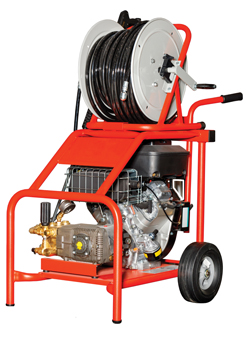
Motor vs. Combustion Engine
By Diane M. Calabrese / Published July 2023

The electrification of everything is well underway. Electric vehicles (EVs) are touted and partially subsidized by the tax code. Charging stations (and transformers) are popping up in supermarket parking lots already short of parking spaces.
The negatives attached to fossil fuels have been put in the balance, and fossil fuels have been declared wanting. Whether the negatives tied to electrified power have been weighed in the same way is a point of contention, but in the foreseeable future it’s unlikely there will be a re-embracement of fossil fuels.
Many local governments in states from coast to coast have already banned construction of new gas lines and forbidden gas hookups for new construction and rehabilitation projects. New York State recently banned new gas connections.
The concept that within just a few years it will be electric power behind the heat, hot water, and stove, or nothing at all (the gas ban in the county where this writer lives begins in 2025), is a bit difficult to grasp.
In fact, our conversations with many people suggest folks do not have a complete appreciation of how fast things are moving. Similarly, within our industry there seem to be plenty of individuals who do not quite believe the combustion engine will be supplanted by motors using electrified power.
Assuming there will not be a reversal of course may be an unwelcome thought, but it is the only practical assumption.
Consequently, it’s valuable to consider how we got to this point—some would label it a period of transition—and the challenges that must be met to see our way through it. Before doing that, though, we get a bit of perspective from two industry members.
[A word on terminology: We strive herein to use the correct terminology to separate the two competing devices that provide the means to accomplish work. They are combustion engines and motors. Motors rely on electrified power.]
On almost any day it’s possible to stumble across an article, online or in print, or an ad that touts the benefits of electrified power. For example, a motor running thanks to electrical power has fewer moving parts and that translates to greater longevity.
Does one power source have the edge when plusses and minuses are counted?
“There are benefits and challenges with both internal combustion engines and electric motors,” says Troy McCall, national sales and engineering manager with American Honda Motor Company Inc. in Alpharetta, GA. “While motors do have fewer moving parts, they also need a different skill set to service, if the motor is serviceable.”
What about a complete move away from combustion engines? Is it possible?
“Theoretically, it is possible,” says McCall. “The challenge everyone is faced with right now is the current technology and packaging of such motor/battery combinations.”
From different vantages, those evaluating and endeavoring to find optimal solutions to society’s requirements for reliable power take a clear-eyed view of issues that require resolution. There are many examples.
To take one example: “The current battery technology and ability to provide enough power long enough for all types of work is proving to be one of the limiting factors in the transition,” says Troy McCall.
Members of our industry have a deep appreciation of the issues that must be resolved in the transition, but they look at it from a can-do standpoint.
“We’re excited for the opportunity and the challenge in going green and being attentive to the environment,” says Curtis Braber, owner of BE Power Equipment in Abbotsford, BC, Canada. He adds he very much wants his company to be part of the transition, and it is.
“The only reservation we have is how quickly we can transition to meet the power difference,” says Braber. At the lower end of the psi range, electric-powered motors can replace gas engines, but not easily at the higher end.
There’s quite a difference between 4000 psi and 40,000 psi. Currently, electric motors do not perform as well as gas at the higher end of the spectrum.
In terms of deploying motors everywhere that combustion engines perform well now, there’s much more to do. “We look at that one as quite a challenge,” says Braber.
Over time, innovation will meet the challenges and make the changeover cost effective, says Braber. Along with innovation, he adds, there must also be more investment in the supply of electrical power, including the grid.
At the level of equipment, there are many features to commend motors. In addition to fewer moving parts, there is also the potential to install auto start and stop features to systems. Such systems “would significantly increase the longevity of machines,” says Braber.
How We Got Here; Where We Are Going
Zero emissions of pollutants and greenhouse gases, as defined by the Environmental Protection Agency (EPA), is not a goal dropped on society, commerce, and industry recently. In 1990 California got things going with a zero-emissions vehicle (ZEV) program, and 16 other states have now adopted the standards of the Golden State.
EPA standards fall under section 177 of the federal Clean Air Act. Regulation of emissions for vehicles quickly extended to other machines. And recently our industry has been drawn into requirements for small off-road engines (SORE).
SORE regulations require spark-ignited engines rated at or below 19 kilowatts (approximately 25 horsepower) to meet emission standards established by the California Air Resources Board (CARB). The standards are pushing a transition to electrically powered motors. That generally means a battery on the pressure washer, not a cord.
Not only is CARB the only state regulatory body that requires no approval of plans from the EPA, but it is also the entity from which the EPA derives most of its initiatives. There may be only 17 states formally committed to zero emissions at present, but one way or another all states will be brought along.
By restricting the sale of non-conforming machines in their states, states that subscribe to zero emissions can nudge manufacturers to build conforming machines. This is where we are. Where we are going is a bit uncertain. Could it be that 17 states do commerce among themselves and the remainder among themselves? We don’t know.
We can expect more rules coming from the federal EPA that aim to yoke in the 33 states. How can that happen? This way—in 2022 the EPA finalized new air quality regulations that add new requirements for owners and operators of stationary engines.
Stationary engines are internal combustion engines (pistons move back and forth and convert pressure into rotating motion). They are used at power and manufacturing plants to generate electricity and power pumps and compressors. They are also used as a source of emergency electrical power and to pump water for flood and fire control.
Combustion engines of every kind—from those in portable generators to those in pickup trucks—are encompassed by EPA rules. Purview of the EPA leads to formulation of regulations such as NSPS [new source performance standards], which require testing and ongoing monitoring for compliance, and NESHAP [national emission standards for hazardous air pollutants].
The United States is not only committed to further reductions in emissions of pollutants, but it has set a goal of 100 percent carbon pollution-free electricity by 2035. See “The Long-term Strategy of the United States—Pathways to Net-Zero by 2050” (unfccc.int/sites/default/files/resource/US_accessibleLTS2021.pdf).
Our readers are quite well versed in the questions surrounding comparisons of motors that are electrically powered and combustion engines. Are the former more efficient, or does the dramatic efficiency difference come because some of the frontside calculations get omitted from the equation? Have impacts of mining cobalt and lithium (human and environmental) been valued in the same way as extracting fossil fuels?
Then, there are other factors often missing from calculations, such as carbon emissions in manufacturing batteries, whether there is a sufficiently strong and resilient grid to support electrification, etc. The great advantage of a combustion engine is that it can operate without the grid. A motor can, too, as long as a battery is available; but when a recharge is needed, what happens?
Is it easier, safer, and more environmentally sound to store and recharge batteries than to refine and store fossil fuel? Perhaps not at present. What do we do with rechargeable batteries that can no longer be recharged? Recycling may be the perfect answer, but there’s no evidence it’s reached a sustainable level.
Yet there’s a great deal of investment going into battery technology. Briggs & Stratton showcased a swappable lithium-battery pack (marketed under the Vanguard name) at a tradeshow in 2022. The pack can be used in tandem with other battery solutions from the company so that larger power needs can be met.
Again, as developments and innovations continue, exacting accounting will aid evaluation. While hybrid vehicles seem to tap the best of both motors and combustion engines, battery electric vehicles require the largest batteries of all vehicle types. Is that a good tradeoff? Does it apply beyond vehicles?
Many questions remain on the road to the electrification of everything. Answering them will make unbiased comparisons possible.



